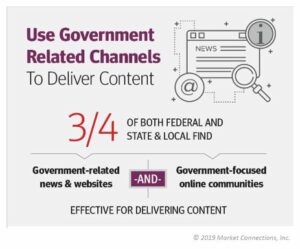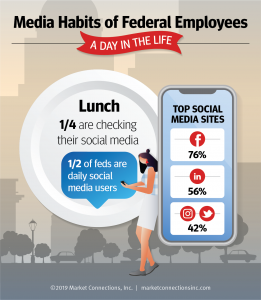Federal Media and Marketing Study
Sara Leiman of TMP Government Shares Insights in Video Discussion
Executive Vice President Aaron Heffron and TMP Government Vice President and Media Director Sara Leiman joined together to discuss key takeaways from the 2021 Federal Media & Marketing Study.
(Synopsis available below the video.)
In her role as a media buyer, Sara provides tactical advice year after year on how she leverages the information and uses data from the study to inform her government contracting clients on where to best invest their media spend.
In this discussion with Aaron, Sara provides key observations around media usage and how she helps her clients develop a media strategy. After seeing the 2021 results, Sara also provides some insights over changes in media, media and news fatigue and changing workforce demographics.
Media Usage
Over the years, Sara has looked at media usage across the entire landscape, whether it be agency type, geographical, or job responsibilities.
Interestingly, this year she found that among Defense respondents nationally, government news media usage had gone up, but general news media (national news providers) usage decreased. Conversely, among Civilian respondents nationwide, general news media had gone up, while government media was less of a clear picture (some had gone up, while others had gone down).
She also looked into respondents within the DC metro area focused in IT, engineering and communications, and saw that national news providers were down, but government media and some of the local general news media had gone up. This was a change from when all news media was up in 2020.
One hypothesis Sara points to is not only media fatigue, but particularly news fatigue. And if media usage is down, our opportunity to reach the customer through this platform also goes down.
When it comes to media usage, Sara points out a key takeaway: the federal customer is not one-size-fits-all. While looking at the general results of the study can provide some insight, the real benefit of the study is the ability to dissect the data by specific audiences to understand their media habits to make the best decisions around media purchasing, especially as media habits shift from year to year.
Developing a Media Strategy
In her role at TMP Government, Sara’s government clients often contact her to provide them with a media plan for their government customers. Before she tackles a plan, she asks her clients to take a step back to understand their strategy. To do this, she asks her clients for key information points that help her develop a strong strategy and plan for the media purchase. These include:
- Target audience
-
- Primary and secondary job functions for decision-makers
- Level of experience
- Location
-
- Inside or outside the beltway
- Where is the best opportunity for sales?
- Timing
-
- Opportunities to cluster placements around product release or tradeshow
Once she has this information, she can mine data from the study to help provide a more informed plan. She provides a sample of some data runs she performs for her clients to create a demographic profile and understands what media they are accessing and what she might recommend.
When it comes to developing a strategy, Sara provides a few key takeaways:
Do not ignore the importance of messaging. Have a clear purpose and connect to something specific because we have less time to capture attention. That message needs to resonate and resonate quickly to get a response.
Amp up other marketing tactics. With the inability to gather in large groups in person, we need to invest in other touchpoints to connect with our customers such as webinars and newsletters.
We need to invest time with people. The study shared key statistics around retirement and hiring which points to a time of transition. While transitions may not be today/tomorrow, they may happen in the short term. What this means is that we will need to educate before we can sell. Ask your clients about their upcoming hiring strategies and offer to educate their new staff, as this can be a huge opportunity to get in front of decision-makers.
Final Thought
According to Sara, it bears repeating, “Every touchpoint and every contact is going to count now more than ever. If we have less time to capture the attention of federal customers, every touchpoint is going to be really important. And that includes not just media, it’s creative, and the events, all of those are the marketing tactics. I think they’re going to mean more now than ever.”
And finally… don’t ignore sports! DC is a sports town! And that won’t change!
Learn more about the Federal Media & Marketing Study:
https://www.marketconnectionsinc.com/fmms2021study/

Aaron Heffron, President, Market Connections
From the Desk of Aaron Heffron, President Market Connections, Inc.
While many of us remember fondly as a kid hearing, “Yes, Virginia, there is a Santa Claus,” we all need to remember, “yes, folks, there will be a federal market after COVID.” Setting aside the debate of when the “after” is a reality, it is not too soon to start thinking about how to position your company to emerge from quarantine stronger and ready for action. You can do this by developing and implementing a marketing plan that accounts for the market realities while it hedges against market uncertainty.
Here are FOUR marketing areas affected by COVID-19 you should reevaluate:
- Events won’t be dead forever, but you’ll need to choose which to attend and sponsor wisely. Our recent COVID related polling of the federal community highlights hesitancy to attend even the smallest of events until the first quarter of 2021. At this point, micro-sized events of under 50 people will be the most likely for federal employees to attend. As you look toward the middle to end of 2021, larger trade shows and conferences may start springing up. Ask event organizers what they are doing to “re-sell” their event. The marketing for the event will be more important than ever as federal employees try to weigh the value of attending. HINT: It’s not only a safety issue.
- Create a webinar strategy that is concise and informative. As remote working and travel restrictions have continued, the prevalence and dependence on webinars has grown. A 45-minute webinar packed with the most recent information, case studies, and forward-looking views is increasingly important as an effective mechanism to educate numerous federal employees at the same time. Rather than scouring online publications and websites for new information, feds are willing to schedule the time to learn both synchronously and asynchronously. Just remember, though, as our content marketing research has shown, minimize the “sell” and maximize the “tell.”
- Adapt your buys to the changes in media usage but hedge your bets. Later this year we will be releasing the 12th edition of the Federal Media and Marketing Study that looks at federal employee preferences for reading, listening and viewing of websites, publications, radio stations and television programming. The survey this year will be measuring habits during the pandemic and we expect to see some drastic changes. The bigger questions will be how long these changes are in place and will longer term behaviors change? Regardless, when the results are public in late October, it will be important to tailor your short-term strategy for media placement and PR to account for these changes. Do not write them off as “temporary” because the tail will be long and may reveal new pathways to the customer.
- Dig deeper to understand what your customer is going through. It will be important to think about how your company will be interactive with your target audience going forward. How affected have your customers and prospects been from the current circumstances? Digging deeper and identifying those specific characteristics of your target audience (including what and who they know) will be necessary, even if you’ve never done it before. Our recent development of federal personas was done with the need for more personal targeting in mind. Individual fears, concerns and values always play a bigger role when there is uncertainty in the market. In 2021 and beyond it will be important to speak to the hearts as well as the minds of the customer as they face fears and concerns that go way past their job responsibilities.
FINAL THOUGHT:
Yes, there will be a federal market in the post-COVID world. What will it exactly look like? Your guess is as good as mine. What we do know now, however, is that with some careful planning and thoughtful actions you can have your organization positioned better than your competitors as new opportunities arise.
Our last blog post “Increased Screen Time Equals More Time with Public Sector Decision-Makers” focused on taking advantage of increased screen time by providing your government customer with content that educates and informs. The next step is to place your content where your customer is already going.
Before placing content on other media channels, take stock of your own corporate site. Approximately 7 out of 10 public sector decision-makers believe that corporate websites are an effective online source for information. If your customer were to visit your corporate site, or preferably a federally focused microsite, is the content they are looking for available and easily accessible? Is your site easily navigable? How far would your customers have to dig to find information around resources they are looking for? Is your site and its contents search engine optimized?
What Online Channels Do They Go to for Content?

From 2019 Content Marketing Review
According to our recent Content Marketing Review, three-quarters of both federal and state and local decision-makers find government-focused online communities and government-related news websites (e.g., GovLoop, Governing, Government Executive or Federal News Network) effective for delivering content to educate and inform their work-related buying process.
We are also hearing from top government-focused publications that increased screen time has driven up the number of visitors to their sites and subscriptions to their e-newsletters. With this in mind, sponsored content or advertising across highly trafficked online sites should be part of your strategy, if budget allows. If it doesn’t allow right now, work with your subject matter experts and other thought leaders in your organization to develop content attractive to these publications. Earned media can often be more effective than paid media.
To make data-based decisions on where to focus your media purchasing budgets, consider sources like the Federal Media & Marketing Study (FMMS) that allow you to strategically match your company’s target audiences with the publications and sites they most frequent. Spending, matched with strategic market information, can maximize your impact.
Learn more about FMMS audience-based reports available for purchase
While federal workers are not necessarily learning new dance moves on TikTok during the workday, they are seeing work-related ads on Facebook, connecting on LinkedIn and following current events on Twitter. Personal devices are present in the workplace and provide access to social media throughout the day. But as with any digital media, preferences can change, usage varies by age and the level of influence can differ by platform.
To understand federal decision-makers’ media usage habits and trends, for over a decade, Market Connections conducts an annual Federal Media & Marketing Study (FMMS). In response to the uptick in the use of social media among the general public, within this study we also ask federal decision-makers about the top social media websites they are using.
Purchase the 2019 FMMS Overview Report
Do Feds Access Social Media at Work?
 People often think that security measures may keep federal employees from checking social media at work, forcing employees to drop their phones at security or leave them in their cars. However, the study found three-quarters of employees can carry personal or work-provided mobile devices into their work environment, providing them a device on which they can possibly check social media. It also found one in ten check their accounts during the workday (in the office), and one in five check during their lunch break. Not surprising, peak usage happens in the evening when four in ten said they check their social media.
People often think that security measures may keep federal employees from checking social media at work, forcing employees to drop their phones at security or leave them in their cars. However, the study found three-quarters of employees can carry personal or work-provided mobile devices into their work environment, providing them a device on which they can possibly check social media. It also found one in ten check their accounts during the workday (in the office), and one in five check during their lunch break. Not surprising, peak usage happens in the evening when four in ten said they check their social media.
Download the 2019 FMMS Infographic: Media Habits of Federal Employees – A Day in the Life
What Social Media Sites Are Feds Visiting?
Facebook continues to top the list with three-quarters (76%) of respondents saying they visit the site. In addition, one-third of respondents (38%) noted being daily Facebook users. This is no surprise considering the majority demographic of survey respondents, half of which are 55 or over and one-quarter being 45-54 matches that of Facebook’s fastest-growing audience. (According to AARP, a recent poll found that Facebook use had an 18 percentage point increase among those 50 to 64 years old and a 14 percentage point jump among people 65 and older.)
Second to Facebook, over half (56%) of the respondents listed visiting LinkedIn. However, interesting to note, while it was the second most-used social site, the frequency is much less, with only one in ten (11%) being daily users.
Instagram and Twitter have continued to experience some growth among federal workers, yet both tied for third with four out of ten federal employees sharing they use these sites.
Purchase a Subscription to the FMMS Dashboard for Detailed Results
Should We Consider Marketing to Feds on Social Media?
Social media is being used and is certainly a viable way to reach the federal audience, however, questions remain:
- Who are they following on social media?
- How are they using social media?
- How would they react to work-related advertising on social media?
- Are they concerned about privacy?
Are there other challenges and issues for those trying to market to feds via social media that should be considered?
The Federal Media & Marketing Study scratches the surface. To get a deeper understanding of social media usage among federal employees, in support of our federal marketing clients, we conducted a survey to answer these questions and more.
See results and insights from this study at our upcoming webinar: “How Are Federal Employees Using Social Media in the Workplace?” on December 12 from 2-3 PM ET.
Follow Market Connections on LinkedIn and Twitter.
 Congratulations to the Washington Nationals who recently won the National League Championship Series (NLCS) and are headed to the World Series! Both local and national audiences will be tuning in to see if the Nats can continue their streak and whether their good luck charm (the baby shark) can take them all the way!
Congratulations to the Washington Nationals who recently won the National League Championship Series (NLCS) and are headed to the World Series! Both local and national audiences will be tuning in to see if the Nats can continue their streak and whether their good luck charm (the baby shark) can take them all the way!
During the post-season, not only are players like Scherzer, Turner or Rendon front and center on people’s TV screens and in-person at games to thousands, but so is the venue they are playing in.
Which begs the question, should government contractors be sponsoring or advertising at these highly visible locations? Was this a missed opportunity for many contractors who want to broaden their brand awareness?
 When sports teams are performing exceptionally, or are just exceptionally popular, venues such as FedEx Field for Redskins fans, Audi Field for DC United and Washington Spirit and finally Capital One Arena who hosts the 2018 Stanley Cup winning Washington Capitals, 2017 division winners Wizards, and recent 2019 WNBA Champions, Mystics, receive much higher visibility and can provide companies with strong brand exposure.
When sports teams are performing exceptionally, or are just exceptionally popular, venues such as FedEx Field for Redskins fans, Audi Field for DC United and Washington Spirit and finally Capital One Arena who hosts the 2018 Stanley Cup winning Washington Capitals, 2017 division winners Wizards, and recent 2019 WNBA Champions, Mystics, receive much higher visibility and can provide companies with strong brand exposure.
Companies such as SAP, Geico, Leidos, Boeing, PNC and others have taken advantage of brand exposure at some of these locations, but would this be a smart investment for other companies trying to get in front of federal audiences?
In 2014, Market Connections asked about federal employees viewing sporting events. Thirty percent stated they watched baseball on TV and 31% had attended a Nationals game in person. In 2015, attending Washington Nationals games in person exceeded any other live sports event, with over one-third (37%) of DC respondents stated they had gone to a game.
How did it fare among feds in the summer of 2019?
Among other questions gauging behaviors of federal employees, we asked feds working in the nation’s capital about the venues they visit. This included a list of sports arenas, museums, theaters, music venues and other highly visited locations in and around the city. Marketers looking to increase their company’s brand awareness in the DC metro area, a major hub of federal activity, can use these findings to help them gauge the value of advertising and sponsorship at these local venues.
Together with findings about their other media and marketing habits including where they go for print, TV, radio, digital and social media usage, federal marketers can take these findings to help them develop or refine their marketing strategy to this unique audience.
Join us on October 31 as we release the 2019 Federal Media & Marketing Study at our annual breakfast briefing at the Center for Education at Wolf Trap in Vienna, VA. Register here.
Can’t make the breakfast? The overview report will be available for purchase for $199. (2018 data available now, 2019 data available mid-November). Learn more.
Need more details? Subscribe to the Federal Media & Marketing dashboard for the most comprehensive data about the habits of federal decision-makers both inside and outside the beltway, across multiple purchase categories, agencies and job roles. Learn more and subscribe.
